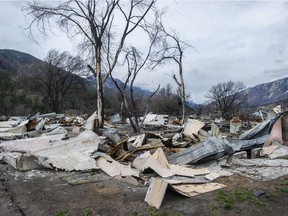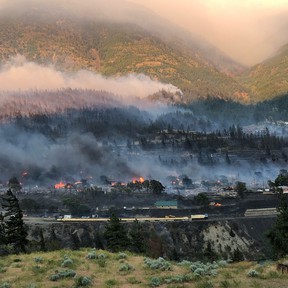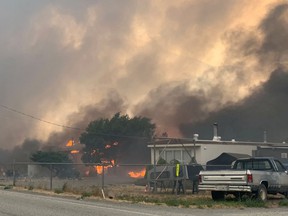Fire spread was from building to building after being ignited by wildfire

Article content
The fire that destroyed Lytton last summer underscores the urgent need to increase the fire resilience of homes and properties in BC that face increasing wildfire threats, according to a report.
Advertisement 2
Article content
The report, commissioned by a BC agency that works with property owners to reduce fire risks, concluded it is unrealistic to expect that firefighters could have stopped the fire in the village.
Instead of focusing on wildfire as the problem, individuals and communities should focus on reducing the chances of homes, businesses and critical infrastructure going up in flames, says the report released Monday.
“The root cause of community wildfire destruction (should) be recognized and redefined … as being a problem of easily ignitable structures and homes, and no longer as merely a wildfire problem,” said the report’s authors, ForestWise Environmental Consulting president Alan Westhaver, and Jack Cohen, a former US Forest Service research scientist.
advertisement 3
Article content
Among two dozen recommendations, including those directed at local and regional governments, is a call for a mandatory 1.5-meter buffer zone around buildings stripped of any fuel that could start a fire.

The recommendations also call for distances between buildings of at least eight meters for one-storey structures and 13 meters for two-storey structures, and for outbuilding and flammable objects such as firewood to be adequately separated from main buildings.
The recommendations suggest mandatory mowing and removal of tall grass and weeds by owners of residential, commercial and corporate lands.
The report was commissioned by the BC FireSmart Committee, and published by the Institute for Catastrophic Loss Reduction. The FireSmart committee includes representatives of the BC and federal governments, BC municipalities, First Nations and fire chiefs.
advertisement 4
Article content
The report found the wildfire spread in Lytton was on the ground rather than in an intense fire in a canopy of trees. It burned through grass, forest litter and shrubs, and was aided by largely short-distance ignitions from a “profusion” of embers.
Within an hour, 20 buildings were fully engulfed in flames in the Interior community. The fire spread primarily from building to building without influence from the wildfire for 1.5 to two hours.
“We need to quit relying on unrealistic fire responses and focus our efforts on reducing the vulnerability of homes and structures and businesses well beforehand if we’re going to avoid disasters like this in the future,” Westhaver told Postmedia.

Last summer, in one of BC’s most extreme wildfire seasons, more than 520 buildings burned and 32,000 people evacuated. Two people died in the blaze at Lytton.
advertisement 5
Article content
The fire hit Lytton on June 30 in the midst of an extreme heat wave and destroyed 151 structures in the Village of Lytton and adjacent Lytton First Nation.
Nearly 170 people are still waiting to rebuild, among more than 1,600 people still displaced from their homes in BC because of wildfires and floods last year.
A Postmedia investigative series, published earlier this month, has highlighted the need for more prevention to mitigate the consequences of wildfires and floods.
The Lytton fire report, drawn from site visits and other information such aerial photos of the fire over time, found wind-driven embers, largely from burning structures, started new fires across streets, continuing the fire spread through the town.
advertisement 6
Article content
The fire spread was also driven by high-risk fire conditions within the immediate areas around homes and the density of buildings that included sheds, workshops and other outbuildings, found the researchers.
Fire & Flood, Facing Two Extremes: Read our 7-part BC investigation
In extreme fire conditions—which many BC communities face each summer—it only takes a handful of dried leaves or pine needles near a building for an ember to spark a fire, noted Westhaver.
Some recommendations were directed at Lytton, including making community wildfire protection their top priority.
Lytton officials said the community is taking steps to enhance fire resiliency as it rebuilds.
More news, fewer ads: Our in-depth journalism is possible thanks to the support of our subscribers. For just $3.50 per week, you can get unlimited, ad-lite access to The Vancouver Sun, The Province, National Post and 13 other Canadian news sites. Support us by subscribing today: The Vancouver Sun | The Province.